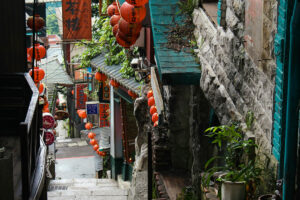(Part 3)
A very concrete example of how to avoid the threat of a global economic slowdown in 2025 is to promote very close economic relations with Taiwan.
Dr. George Manzano, an expert in international economics at the University of Asia and the Pacific opines that the Philippines could attract foreign investors (not only from the US) that are looking for other countries to use as export platforms in order to circumvent the tariffs on China. A low hanging fruit is to take advantage of the trade war to continue increasing our exports to Taiwan and attracting more Taiwanese factories to locate in the Philippines instead of China.
Already, in the first quarter of last year, the total trade between the Philippines and Taiwan had grown 12.22%, which had been valued at $1.67 billion. As reported by Myrna Velasco, Philippine Trade and Investment Center (PTIC) Taipei Trade Representative and Director for Commercial Affairs Anthony Rivera highlighted that “Taiwan serves as a source of sustainable export-driven trade and investments anchored on environmental, social, and corporate governance (ESG) and green manufacturing to generate more jobs in the Philippines.”
Now that Taiwan and the Philippines are usually mentioned in the same favorable breath as the closest allies of the US in the Indo-Pacific region by US President Donald Trump and his top government officials (like Secretary of State Marco Rubio), there should be efforts by both the Government and the Philippine business sector to maximize opportunities for increased trade and investment relations. Mr. Rivera emphasized that Taiwan’s investments in the Philippines ranked 8th and had been rated as having “one of the fastest growth rates among 41 countries with 523% growth in the first quarter of 2024.”
The PTIC noted the preferred destinations of Taiwanese investors are the sites being promoted by the Board of Investments (BoI), as well as the Subic Bay Metropolitan Authority (SBMA), the Philippine Economic Zone Authority (PEZA), and Clark Development Corp. (CDC). In fact, in a road show promoting Philippine-Taiwan trade and investment relations held in Taipei on June 12, 2024, there was a Taiwanese industrialist who represented an industrial zone exclusively for Taiwanese factories in Clark. The participants in the road show emphasized the importance of the industrial manufacturing sphere spanning across sectors that also cover electronics, semiconductors and electric vehicles (EVs); then technology, media and telecommunications; health and life sciences; and modern basic needs as well as environment and climate change.
A Visiting Professor from Taiwan at the UP School of Public Administration, Dr. Eing Ming Wu, recently pointed out to me that there is an equivalent Economic Corridor that can connect Taiwan with Northern Luzon, especially Batanes, the Ilocos Region, and the Cordillera Administrative Region. Kaohsiuing, the leading industrial city in Taiwan, can transfer a great deal of its technology to this “Northern Luzon Economic Corridor,” not only in high-value electronics and semi-conductor manufacturing but also in the development of “smart cities” in which Taiwan is highly advanced.
Through the “Look South” policy of the Taiwanese Government, we can turn to this neighboring territory for financial and technical assistance, to fill whatever vacuum may result from the temporary (or in the event, permanent) significant decline in development aid from the US because of the closure of the US Agency for International Aid (USAID) that was established during the Kennedy years in the 1960s. In my opinion, this was a case of “throwing the baby with the bath water” of the Trump Administration, as we shall discuss below.
ALTERNATIVE DEVELOPMENT AID SOURCESMeanwhile, both the Government and the private sector of the Philippines must actively search for alternative sources of development aid, such as those we can receive from Japan, South Korea, Singapore, and Taiwan among our East Asian highly developed neighbors.
As Professor Wu pointed out to me, the Philippines is geographically closest to Taiwan, the world’s most diverse and well-clustered industrial supply chain hub, a 90-minute plane ride from Manila and 91 kilometers from Batanes.
Taiwan’s industrial supply chain development is highly automated, advanced, and innovative. Each factory seems to have its own proprietary technology, with companies employing highly skilled labor, conducting independent R&D, and integrating across different fields. Its private sector benefits from a very supportive government that plays a very important role in supporting industrial development and technical advancement.
Our two territories should take advantage of our being cited by top US government officials, starting with President Trump himself, as their strongest allies in the Indo-Pacific region. Here again, we can convert the political threat from China to our respective societies as an opportunity to get closer to one another in trade and investment. It is also providential that our young and growing workforce complements very well the shortage of workers in Taiwan and their rapidly ageing population. Taiwan has one of the lowest fertility rates in the Indo-Pacific region.
As is illustrated in the case of our relations with Taiwan, the global crisis that will surely result from the tariff wars provoked by the protectionist policies of President Trump, can be transformed into an opportunity to start building up the annual flow of $15 billion to $20 billion of foreign direct investments (FDIs) that we need to accelerate our GDP growth to the higher rate of 8% or more that is needed to bring down our poverty incidence to single-digit levels by the end of the Marcos Jr. Administration.
The Philippines can serve as an alternative venue for export-oriented manufacturing enterprises seeking to avoid the higher tariffs that will be imposed by the Trump Administration on countries that have very high foreign trade surpluses with the US. Once again, the historical weakness of our export manufacturing sector can be converted into a strength as the US wages a tariff war with the major exporting nations in the Asia-Pacific region.
To make sure that the higher FDI figures will redound to the benefit of the close to 20 million Filipinos who are living in dehumanizing conditions because they are below the poverty line, we must also try our best to attract development aid from countries other than the US, just in case the closure of the USAID is permanent and development aid from the US is decreased significantly. As I mentioned above, a complete closure of USAID would be a case of “throwing the baby with the bathwater.” This is without denying that even in the Philippines, some USAID officials in the past went against the pro-life principles of Filipino culture enshrined in our Constitution by promoting the use of contraceptives that were abortifacient. This would constitute part of what President Trump refers to as “wokeism.” There are, however, numerous examples of USAID programs that have done a lot of good to Filipinos, especially the poor.
Let me list just a limited number of these programs with which I am familiar:
1. Regulatory Reform Support Program for National Development (RESPOND). This aimed to improve the regulatory quality of government agencies that would ultimately lead to enhanced competitiveness, contributing to higher levels of investment and trade, inclusive growth, and self-reliance. Within the original five-year duration of the project, the policy advocacies of RESPOND resulted in the passage of key legislation that removed or lowered the barriers to trade and investment, thereby making the country more attractive to FDIs.
2. Urban Connect. The goal of this program was to promote inclusive and resilient economic growth in nine secondary cities within the USAID City Development Initiative framework — Batangas, Iloilo, Cagayan de Oro, Zamboanga, Tagbilaran, Tacloban, Puerto Princesa, General Santos, and Legaspi. I was personally involved in this program as a regional economic consultant. The information that resulted from the research provided a great deal of insights to the LGUs of Batangas, Iloilo, and Cagayan de Oro who were able to formulate very concrete plans for infrastructure development that have made them real alternatives to Manila as international and regional centers, significantly improving their attractiveness to investors, both domestic and foreign. This is especially true for Iloilo that is now an alternative to Metro Manila for real estate, tourism, and Business Process Outsourcing-Information Technology, or BPO-IT, investments.
3. Better Access and Connectivity (BEACON). This aims to promote economic growth through better information and communications technology (ICT), helping bridge the digital divide in the Philippines. Through BEACON, USAID was to improve the Philippines’ ICT and logistics infrastructure; strengthen the regulator, business, and innovation environment; and bolster cybersecurity.
4. Cities for Enhanced Governance and Engagement (CHANGE). This program sought to strengthen democratic governance in the Philippines by making local governance more responsive. It purported to strengthen the enabling environment for decentralization, improve cities’ readiness for effective citizen engagement, and building capacity for multisector collaboration and collective action. In addition to the major cities covered by the Urban Connect project, the following secondary LGUs were added: Masbate, San Fernando (La Union), Tagum, Tanay, and Victorias.
5. The Partnership for Skills, Innovation and Life-Long Learning (UPSKILL) program aimed to strengthen the Philippines’ higher education system for broad-based, inclusive growth. It aimed to support innovation and workforce development functions of Philippine higher education institutions (HEIs), faculty development, and curriculum improvements. It aimed at increasing engagements for HEIs with industry and international partners, as well as bring design-thinking concepts to HEI management and administration.
It is clear from the above small sample of developmental assistance that USAID has been extending to Philippines society that it is not fair to judge the entire organization for the woke-oriented activities that were promoted by this international organization in some countries. There is no rationale for completely stopping the activities of this international organization that has brought a lot of good to developing nations since the Kennedy Administration in the 1960s.
Hopefully, after purging the organization of the programs deemed objectionable by the Trump Administration, the US Government will continue to extend development aid to many of the poorer countries all over the world that need assistance in reducing poverty, educating their youth, upskilling their human resources and improving governance, especially at the LGU level.
Bernardo M. Villegas has a Ph.D. in Economics from Harvard, is professor emeritus at the University of Asia and the Pacific, and a visiting professor at the IESE Business School in Barcelona, Spain. He was a member of the 1986 Constitutional Commission.
bernardo.villegas@uap.asia

